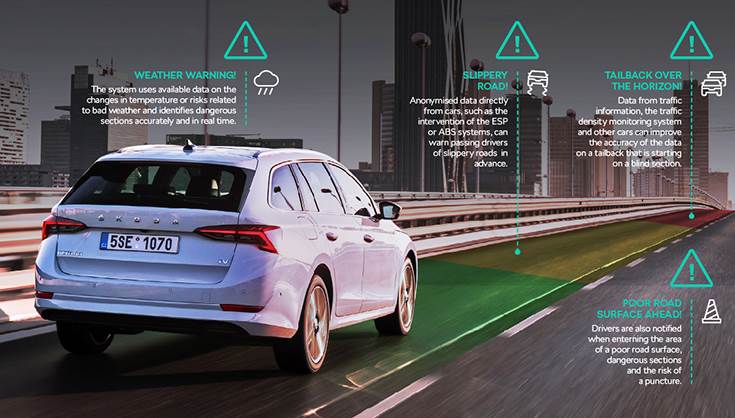Skoda Auto’s latest tech update is a swarm data intelligence-based service to warn drivers of slippery roads. The Czech carmaker’s ‘Local Hazard Information Service’ provides drivers with detailed information about current road conditions.
The system collects and evaluates anonymous data and, if necessary, warns of a slippery road surface or road damage via the infotainment system, thereby increasing active safety. The service is based on swarm data intelligence: the more vehicles are connected, the more data is available for the system to analyse, and the more precise the predictions.

According to Skoda, the ‘Local Hazard Information Service’ detects low surface adhesion on upcoming road sections and predicts when it will be dangerous – for example, due to icy conditions. In this case, the driver will be alerted via the vehicle’s infotainment system. The information required for this comes from the car itself. It can detect even a minor change in traction on the road surface and then sends the data anonymously via a Car-to-Cloud application. The transmitted information produces swarm data, which is then analysed to create maps that show localised hazards in the vehicle’s immediate surroundings and – if necessary – notify the driver of the hazard.
Sebastian Lasek, Head of Product Line Connectivity at Skoda Auto, says: “The system uses the car’s sensors to detect challenging road conditions in advance. To this end, the ‘Local Hazard Information Service’ increases active safety for drivers and passengers. We are continuously developing our connectivity services to offer our customers extra safety features and even more convenience.”
Sensors enable road damage to be detected in good time
Among other things, accelerometers or ABS sensors allow the required data to be captured continuously during the entire journey. The integrated software also uses virtual sensors. This innovative technology can estimate the coefficient of friction between the tyres and the road surface based on wheel slip. The sensor data is anonymised when transmitted to the cloud.
The aggregated information from all vehicles is then combined with metadata, such as weather information or previously measured information. Subsequently, the data is transmitted to a service provider. Using the data collected, the road network is then displayed as a precise three-dimensional model, which is used to send alerts to vehicles when they approach or already find themselves in an area with bad road surfaces.
Sensor data opens up numerous usage opportunities
The underlying technology can be used for numerous other applications too: for example, road authorities can use the data to obtain real-time information about different road sections, allowing them to gain insight into the condition of the road network. They can find out where the potholes are, which areas are slippery when wet, or tend to freeze quickly. The data can also provide information as to which roads have already been gritted or cleared.
Swarm intelligence enables precise analyses and builds the self-learning system
The more vehicles provide data, the more accurate the swarm intelligence-based analysis, maps and information and/or driver alerts will be. Over the course of 2021, more than 1.7 million Volkswagen Group vehicles in Europe will supply the data. By the end of 2022, this figure will rise to more than three million vehicles. The ‘Local Hazard Information Service’ is available for the Enyaq Iv, Fabia, Kamiq, Karoq, Kodiaq, Octavia, Scala and Superb and is part of the škoda Connect services. The service can be used in 30 countries, provided that the vehicle features the Amundsen or Columbus infotainment system.
/news-international/skoda-uses-swarm-data-intelligence-to-warn-drivers-of-slippery-roads-79245 Skoda uses swarm data intelligence to warn drivers of slippery roads Skoda uses swarm data intelligence to warn drivers of slippery roads https://www.autocarpro.in/Utils/ImageResizer.ashx?n=http://img.haymarketsac.in/autocarpro/1cda1787-e33e-4911-86f9-fcf53a6ef798.jpg
